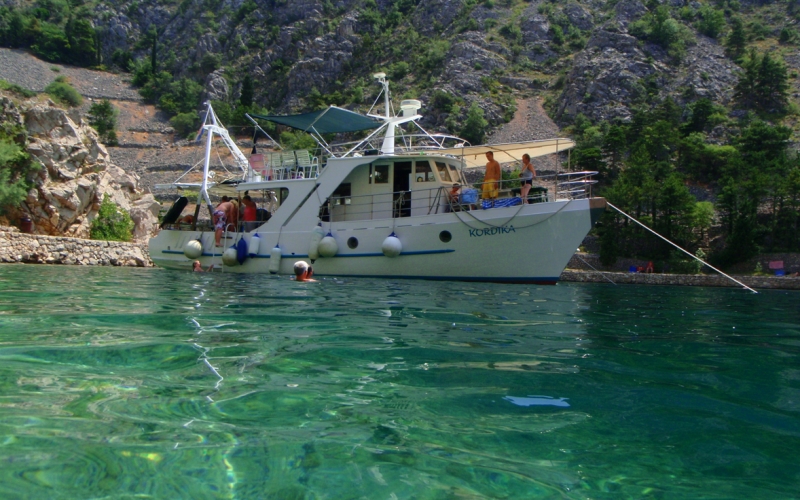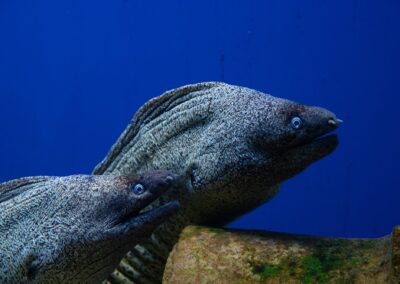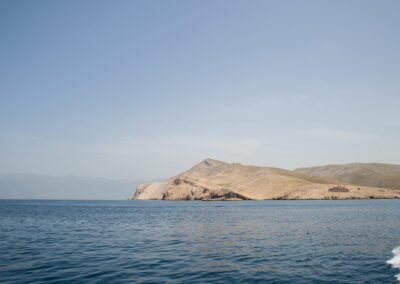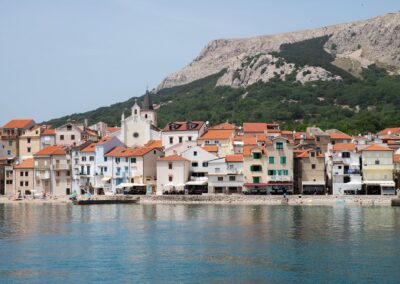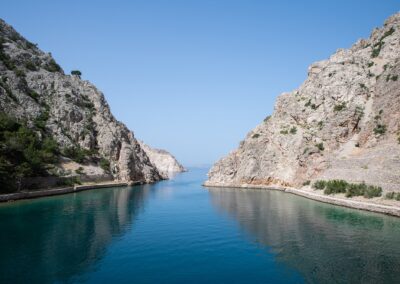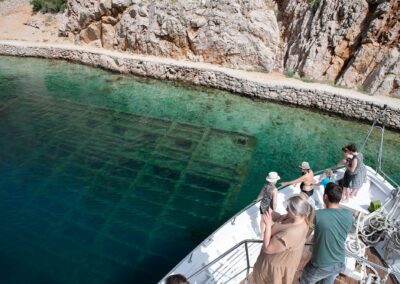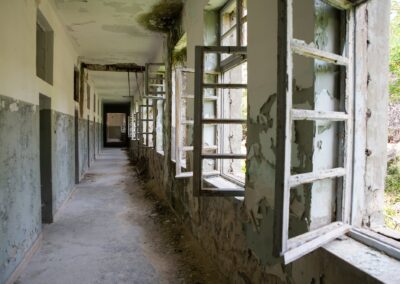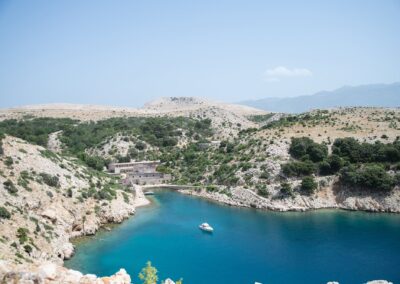Leaving the port of Rab at 9.30 a.m., We sail through Barbat Channel to Zavratnica Cove, where we turn and continue sailing past Jablanac and Stinica toward Goli Island. Where we stay until 1.30 p.m. In the meantime, lunch is served around 1.00 p.m. to guests who have paid for this service. We then sail along the northern side of Goli Island and Prvić Island and on to Baška on the island of Krk, where we arrive in about 45 minutes and where we stay until 4 p.m. Continuing along the northwestern coast of Rab Island, we stop for a swim in one of the many gorgeous coves on the island’s eastern coast. We arrive back in Rab at 6.00 – 6.30 p.m.
Throughout the entire trip, our crew will provide you with a commentary on all sights in five languages.
Lunch: fish or meat, salad, bread
Price of excursion: 45 EUR
Price of lunch: 15 EUR
Sights to see
The Barbat Channel separates Rab Island from the neighbouring, uninhabited islet Dolin. The remains of a small, early-Christian church and a fortress are found on the hill of St. Damian overlooking the village of Barbat. While sailing, you can also see the Parish Church of St. Stephen, built in 1850 on the foundations of an 11th century Benedictine monastery. .
Zavratnica is a picturesque cove. As it is only 25 metres wide at its entrance and penetrates deep into the mainland, it has often been called a fjord. Being part of the Velebit Nature Park, the cove is a protected area. We turn around in the cove over a sunken WWII lighter (barge), giving you a view of it while telling you its interesting story. The cove is also known for the fact that a Winnetou movie “The Treasure of Silver Lake” was shot here.
Goli Island is well known for its infamous past. It was a prison, opened in 1914 to hold Russian WWI prisoners. From 1948 to 1988 , it served the communist regime as a prison for political prisoners, and during this time, more than 50,000 prisoners passed through it. The prison could hold a total of 5,000 prisoners. Located around the island, the buildings that were witnesses to human suffering in those terrible times are mostly in disrepair. Today, there is a restaurant in Mala Tetina Cove, as well as a movie theatre where you can watch a 10-minute documentary about the island. A tourist train has been in service since 2009. While some vegetation, planted by prisoners, can be found on the western side of the island, it is otherwise barren, hence, its name – Goli (naked, barren).
The southernmost town on the island of Krk, Baška is the cradle of Glagolitic script. The most famous glagolic monument and one of the oldest inscriptions in the Early-Croatian language dating from the 11th century – the Baška Stone Tablet –was found in the Church of St. Lucy in the village of Jurandvor near Baška. Baška is an old coastal town with architecture typical of the region and many cultural and historical monuments. The old part of the town with authentic coastal features is concentrated in several rows of houses encircling the port. Today, Baška is best known for its beach that many tourists visit. The beginnings of tourism in Baška date back to 1904. In 1906, the first hotel was opened, and in 1908, a swimming beach with auxiliary facilities was built. Czechs were the first guests, thanks to Emil Geistlich, director of the Prague newspaper “National Politics”. A monument in his honour has been erected near the beach.
The baroque Parish Church of the Holy Trinity is in the town centre. Built in 1723, its interior is decorated with a large altar painting by Franjo Jurić and a renaissance painting, “The Last Supper”, by Jacopo Palma (1544 – 1628).
Next to the parish church is the Baška Native Museum displaying the region’s artistic and ethnographic treasures. The museum holds a special room dedicated to the Czech doctor, Zdenka Čermakov, who came to the island in 1910, where she remained to live and work. For a time, she was the only doctor on the island.
The Church of St. Anton, dating from 1482, i s decorated with paintings by the renowned Croatian painter, Celestin Medović (1859 – 1920). The Church of St. Mark (1514) was built on an early-Christian mosaic, and the remains of a Roman settlement from the 2nd century BC were found in its vicinity. Another interesting fact: Mass in held in the Church of St. John the Baptist only on 24 June on St. John’s Day. The church’s steeple is painted in dark yellow, and a cemetery surrounds the church. . .
Upon arriving in Baška, you can go for a swim on the beautiful, 2-kilometre-long pebble beach or you can visit the aquarium housing hundreds of fish from the Adriatic Sea and some 400 species of snails and bivalves. When visiting the aquarium, be sure to show your boat excursion tickets at the ticket office and get a discount on the admission fee.

